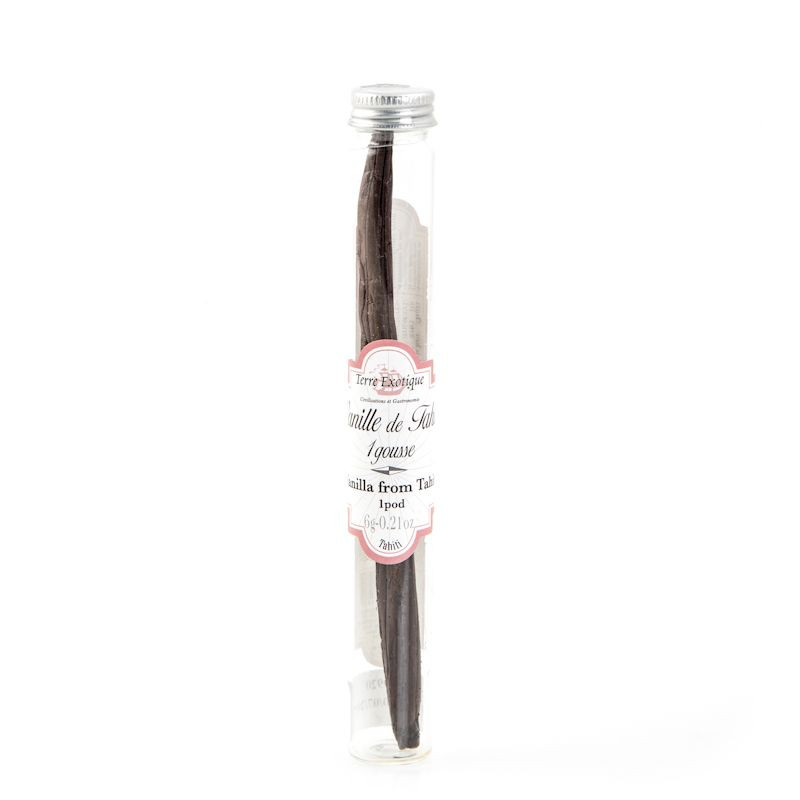



The pod of Tahitian vanilla is thicker than that of the better known Bourbon vanilla and the aroma is somewhat reminiscent of anise. Its pulp has a characteristic plum-like smell. Thanks to its rich flavor, it is suitable for sweet and savory dishes and is very productive.
Data sheet
Let yourself be surprised by the anise flavor of Tahitian vanilla! Unlike the much better known classic vanilla from Madagascar, Tahitian vanilla surprises with its rather spicy flavor. Its pod is thicker and plumper than that of Bourbon vanilla, and its flesh has a characteristic plummy smell and a varied flavor reminiscent of anise. Being fleshier and more aromatic than its related species, even a half or quarter pod will do well to enhance savory or sweet dishes. In addition, it also enjoys great popularity in the perfume industry.
Vanilla tahitensis or Tahitian vanilla is the result of crossing two species. The two varieties, Vanilla planifolia and Vanilla odorata, were early inter-pollinated in tropical areas. Through these successful crosses, Vanilla tahitensis was born. The orchid is rooted in the heart of humid valleys in humus-rich soils and blooms on the shady trees or tender acacias on which the tendrils climb.
Polynesian vanilla is three to four times thicker than Bourbon vanilla. Its peculiarity is that it does not split, this means that it does not open its capsule like the other types of vanilla and form two pods from one flower. Thus, it retains all the power of its aromas. Harvested three months later than Vanilla planifolia (Bourbon vanilla), it is ripe at this time and thus offers a much richer aroma.
The Tahitensis vanilla from Raiatea is larger, lighter and fleshier than the Bourbon vanilla. The overwhelming aromas of caramel and anise are immediately perceptible and the pulp smells like plums.
It offers floral and buttery-salty notes of surprising subtlety. Along with Bourbon vanilla, it is the most famous type and most sought after by top chefs. Thanks to its aniseed note, Tahitian vanilla can be used in both sweet and savory recipes. With cream, custard or tropical fruits, it unfolds all its flavor. In a savory version, it brings a delicate flavor to your fish dishes or summer salads.
The Tahitian vanilla can be used in the same way as the Madagascar vanilla, but you should be careful with the new flavors at the beginning, because for the palate it is just not the typical vanilla flavor as you know it from the bourbon vanilla. This is due to the vanilin content. Bourbon vanilla is rich in vanilin, which is responsible for the classic vanilla scent. Tahitian vanilla contains hardly any vanilin, but offers a variety of other components with a typical odor pattern.
Since these are more prominent than the vanilin, we recommend for most recipes to use only half or a quarter of the pod for a recipe. In this way you get a delicious and exciting flavor without it taking over.
Tahitian vanilla was born in the middle of the 19th century in the heart of Polynesia. In 1848, an admiral introduced Aromatica plants to Tahiti. He was followed two years later by Admiral Bonnard, who imported other vanilla plants. The crossing of these two species gave rise to Vanilla tahitensis, which was first cultivated in private gardens.
Large-scale cultivation began in 1880. It was grown on most of the mountainous islands. These offer an exceptionally warm and humid climate, cooled by the light breezes of the trade winds. This vanilla is primarily grown in the Company's archipelago on the island of Raiatea, which is also called the "sacred island" and is the cradle of the Polynesian people.
The cultivation of Tahitian vanilla requires patience, sensitivity and attention to detail. The flowering period takes place between June and October, stimulated by the cool southern winter. Surprisingly, the flowers have a very short life of only a few hours and opens at sunrise. There is no pollinating insect on the islands for these human introduced plants, so this must be done by the farmers. Hand pollination must be fast and very efficient because of the short flowering time. If it is done well and quickly, one can even hope that each flower will produce a pod.
After nine months of gestation, after the "marriage" by the human hand, the ripe pods are carefully picked and dried in large piles in the shade until they turn brown. It is then washed again and again for several weeks, dried again in the mild morning sun and packed in boxes while still warm for sweating. For best quality, the vanilla is then smoothed and worked by the farmers with their fingers to regulate the moisture content. Once they are perfectly processed, they are packed and shipped.
| Energiewert in kJ | 1205 kJ |
| Energiewert in kcal | 288 kcal |
| Fett | 0.06 g |
| davon gesättigte Fettsäuren | 0.01 g |
| Protein/ Eiweiss | 0.06 g |
| Salz | 0.00 g |
| Kohlenhydrate | 12.70 g |
| davon Zucker | 12.70 g |
Allergen information
 Puff pastry cornets filled with vanilla cream
Puff pastry cornets filled with vanilla cream
 Make vanilla cream at home
Make vanilla cream at home

The pod of Tahitian vanilla is thicker than that of the better known Bourbon vanilla and the aroma is somewhat reminiscent of anise. Its pulp has a characteristic plum-like smell. Thanks to its rich flavor, it is suitable for sweet and savory dishes and is very productive.